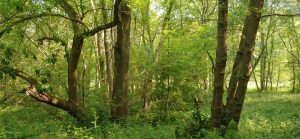Summary
A project was commissioned to estimate and compare the potential for carbon sequestration (net CO2 uptake) and GHG emissions mitigation that could be realised by creating different types of woodlands.

The analysis assesses the influence of different tree species, site and management factors, including the eventual use of harvested wood, on the potential carbon sequestration and GHG emissions, at the scale of an individual forest stand (i.e. in terms of quantities of carbon per hectare), and for notional woodland creation programmes of 1 hectare per year for 1 year and over 10 and 25 years.
Research Objectives
The purpose of this research was to assess the influence of different factors on the potential for carbon sequestration and GHG emissions mitigation that could be realised by creating different types of woodland.
Factors considered included:
- Tree species
- Site characteristics
- Woodland management
- Use of harvested wood products
Findings and Recommendations
Key messages
- This report by Forest Research is a systematic analysis of the rate of net CO2 uptake over time as a result of creating a wide range of different types of woodland in the UK. The analysis includes potential future avoided GHG emissions through using wood products in place of other materials and fuels. Twelve types of woodlands were analysed covering coniferous and broadleaf woodlands and natural recolonisation.
- The results show that all the woodland types deliver significant net CO2 uptake over a 100-year period, and nearly all in the 2022 to 2050 period. None result in significant net GHG emissions during this time.
- Rates of CO2 uptake vary between woodland types. In shorter timescales (e.g. up to 50 years), a fast-growing conifer plantation can achieve the highest CO2 uptake rates. Over longer timescales, the CO2 uptake rates of different woodland types become closer to one another.
- Often, broadleaves are slower growing than coniferous trees but can eventually ‘catch up’ with the amount of CO2 captured by coniferous woodlands.
- Wood products can provide a significant store of carbon and can avoid emissions when they substitute for other materials. These effects are most apparent for new woodlands managed for production over longer timescales (2022 to 2100), when these woodlands start to produce timber. These contributions can be almost as important as carbon sequestration in the woodlands over this timescale.
- Net CO2 uptake rates differ more between woodland types over shorter timescales reflecting greater variations at this stage in tree growth rates, silvicultural practices (thinning) and soil carbon stock changes related to woodland establishment.
- Good woodland design and management are critical to achieving early CO2 uptake, for example by minimising disturbance to soil and existing vegetation when planting. This is particularly the case for woodlands where the trees have relatively slow growth rates.
- Different woodland types will be better suited to different regions of the UK and particular site types. The different woodland types are not all interchangeable in the same locations or sites within the UK. Care must be taken when making simple comparisons across the different woodland options.
- The report also found that the modelling results were consistent with experimental measurements of CO2 uptake rates where these were available.
Publications
A Summary report giving the key findings and recommendations of this project is available on this web page.
A full report, giving full details of the project and its findings, is also in preparation and will be made available on the same page as soon as it is completed.
